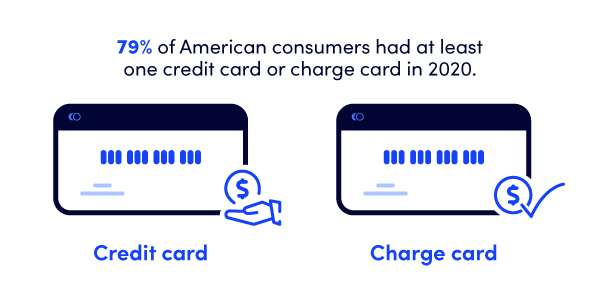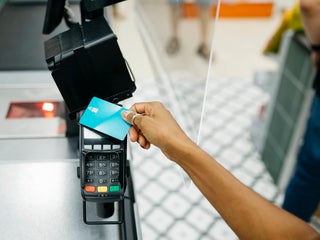Summary
How many credit cards does the average American have, and what types do they have? We’ve compiled industry statistics to answer those questions and more about who’s carrying what cards.
The content on this page is accurate as of the posting date; however, some of our partner offers may have expired. Please review our list of best credit cards, or use our CardMatch™ tool to find cards matched to your needs.
Consumers have not been immune to financial challenges in the grips of a global pandemic. One way lenders are responding is by tightening their standards when issuing credit card accounts as the number of credit card accounts continues to fall.
According to data released in May 2021 by the American Bankers Association, there were 365 million open credit card accounts in the U.S. as of the end of 2020.
That number includes 203 million accounts held by superprime consumers, 98 million held by prime consumers and 64 million held by subprime consumers. According to the ABA data, the number of credit card accounts decreased for the third quarter in a row.1
While the number of prime and subprime accounts dropped to levels not seen since 2015-2016, the number of superprime accounts hit an all-time high, suggesting that those with the best credit have plenty of options to choose from.1
See related: How to choose the best credit card
How many Americans own credit cards?
Despite the decline in credit card accounts, credit cards are found in most Americans’ wallets. Federal Reserve Bank of Atlanta data released in May 2021 found that in 2020, 79% of consumers had at least one credit card or charge card, which is the highest percentage since the Fed began conducting the Survey of Consumer Payment Choice in 2008.2
A credit card is defined as a card that allows the cardholder to make a purchase by borrowing funds paid back to the credit card company later. A charge card is a type of credit card that must be paid off in full every month.

Using the U.S. Census Bureau estimate of 253 million adults in the U.S.,3 that means nearly 200 million American adults have a credit card, a charge card or both.
However, lenders have shown caution when extending new credit, perhaps due to Americans’ financial challenges during the pandemic. Average new account credit lines decreased to $3,696 in the first quarter of 2021 from $5,128 the year before, according to a May 2021 TransUnion report. And the number of credit cards fell from 457.6 million in Q1 2020 to 454.6 million in Q1 2021.4
According to a survey conducted in August 2020 by Travis Credit Union, more and more Americans are going cash-free. Fifty percent of respondents said they used cash less during the pandemic than they did before the COVID-19 crisis. On top of that, 58% said they planned to stop using cash entirely after the pandemic.5
See related: How COVID-19 is possibly leading the cashless revolution
Types of credit cards Americans own
Americans tend to hold a variety of cards, but cash back credit cards are most popular. According to a 2021 survey of 2,000 Americans by The Ascent, from the investing site The Motley Fool, 46% of Americans own a cash back credit card, down from nearly 60% who had a cash back credit card in 2019. Also, 31% own a retail credit card, 25% own a low-interest card and 19% own an airline or other travel credit card.6
Card ownership by age
Older consumers tend to carry the most cards. According to Experian, in the third quarter of 2020, baby boomers – those between 56-74 – carried, on average, 4.61 cards followed by:
- Generation X – those between 40-55 – who carried 4.23 cards on average.
- The silent generation – those 75 and up – carried 3.64 cards, on average.
- Among younger cardholders, millennials – those between 24-39 – carried on average 3.18 cards and Generation Z – those between 18-23 – carried 1.91 cards.7
Young Americans are waiting longer to get their first credit card, possibly because younger consumers also are dealing with student debt. Additionally, the Credit CARD Act of 2009 bans credit card approvals for anyone under 21 years old unless they have an adult co-signer or can prove they have sufficient income to pay the bills.
However, that doesn’t mean young people are not using credit cards.
- According to Sallie Mae’s 2019 “Majoring in Money” report, 57% of undergraduate students owned a credit card in 2019, and 38% of undergraduates have two or more cards.8
- However, a higher percentage of college students (19%) have only one card, compared with college graduates or people who didn’t finish college (14%).8
- Debit cards are still more popular, and 85% of undergraduate students carry debit cards. Students overall are more likely to use debit (85%) or cash (81%) than credit cards (57%).
- Students prefer cash over any other payment method for in-store purchases of less than $20. Forty-three percent of college students do not use credit cards at all.8
The Ascent survey showed that while nearly 55% of consumers have maxed out at least one credit card, Generation Z (44%) was least likely to do so, followed by baby boomers (48%), millennials (51%) and Generation X (66%).6
However, millennials were most likely to fall more deeply into credit card debt because of the pandemic, according to a CreditCards.com survey conducted in May 2020. More than a third of millennial cardholders – 34% – said they incurred more debt during the pandemic compared to 23% of Generation Xers and 15% of baby boomers.9
Card ownership by state
Where you live can also play a role in how many credit cards you have. In every state, the average number of credit cards owned by consumers dropped in 2020, according to a 2021 study by Experian.7
- New Jersey residents had, on average, the most credit card accounts in the third quarter of 2020 with 4.54. Other states in the top five include Connecticut (4.21), Rhode Island (4.16), Florida (4.15) and New York (4.14).7
- On the low end, Alaska residents had the fewest credit card accounts in the third quarter of 2020, with 3.06 accounts. They were followed by South Dakota (3.22), Mississippi (3.26), the District of Columbia (3.26) and Wyoming (3.28).7
See related: 2020 state debt burden survey
Card ownership by credit score
Superprime (those with credit scores greater than 759) and prime borrowers (those with credit scores between 680-759) make up most credit card account holders. In fact, prime and above consumers represent 82% of all open credit card accounts, according to the ABA report.1
In Q4 2020, there were 31 million new accounts issued for superprime borrowers, 23 million new accounts issued for prime borrowers and 16 million issued for subprime borrowers (those with credit scores less than 680).1
Sources
- American Bankers Association Credit Card Market Monitor, May 2021
- The Federal Reserve Bank of Atlanta’s 2020 Survey of Consumer Payment Choice, May 2021
- U.S. Census Bureau July 2019 estimate of U.S. population, and U.S. Census Population by Age and Sex 2019
- TransUnion Industry Insights Report, Q1 2021
- 2020 Travis Credit Union Cash Survey
- The Ascent from Motley Fool, “How Gen Z, Millennials, Gen X and baby boomers use credit cards”
- Experian, “What is the average number of credit cards per U.S. consumer?”, April 2021
- Sallie Mae “Majoring in Money” report, 2019
- CreditCards.com, “Poll: 23% of consumers added to their card debt during the pandemic,” May 2020
Editorial Disclaimer
The editorial content on this page is based solely on the objective assessment of our writers and is not driven by advertising dollars. It has not been provided or commissioned by the credit card issuers. However, we may receive compensation when you click on links to products from our partners.




